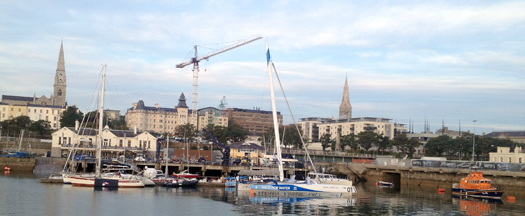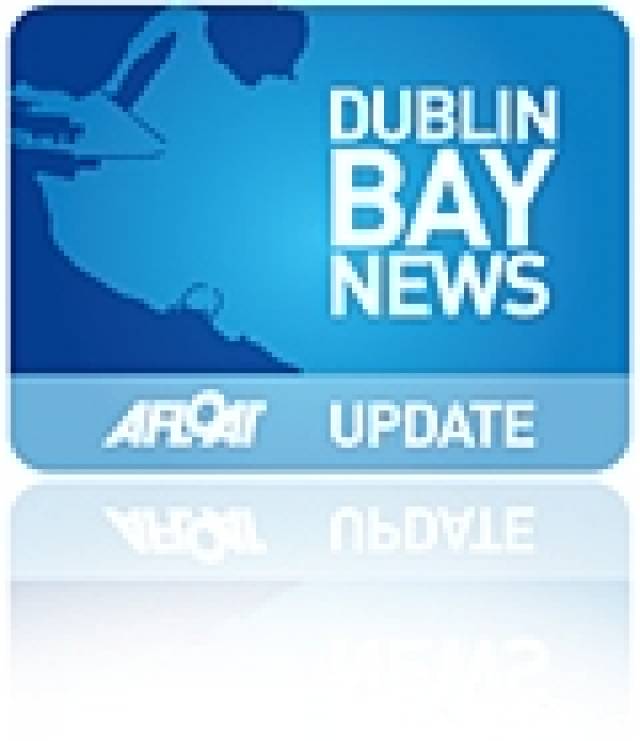#mod70 – Like giant exotic creatures from another planet the MOD70 Trimaran fleet arrived in Dun Laoghaire overnight after their first leg from Kiel in Germany. With one colourful hull suspended in air even early morning joggers on Dun Laoghaire's East Pier stopped to view the new arrivals into the Carlisle basin. Sails down and safely berthed near the town bandstand the five boat fleet there is no sign of life on board this morning as the 70-foot long craft dwarf all locally based craft at the National Yacht Club, adding a touch of Autumn glamour to the East coast port.
After around 1400 miles and three and a half days of hard racing from Kiel to Dun Laoghaire, Ireland just 77 seconds finally separated the top three MOD70 one design trimarans when the MOD70 European Tour leaders broke the finish line in a dying breeze just after midnight on Dublin Bay.

Four of the Trimarans are along side the Carlisle pier and one is berthed on the National Yacht Club pontoon
It was a heart-stopping conclusion to the first of the five offshore legs which takes the fleet from Germany to Genoa, Italy with stops in Dublin, Cascais and Marseille. Michel Desjoyaux's crew of FONCIA had only seized the lead from long-time pacemakers Spindrift racing within the final 15 miles of the finish.
But within 50 metres of the finish line in the fickle, patchy breeze they had slowed to a crawling two knots.
They only just squeezed across the finish line, 31 seconds ahead of Yann Guichard's Spindrift racing which in turn only just held off Sébastien Josse's hard driving young crew on Groupe Edmond de Rothschild who missed out on second by only 46 seconds.
"It was tough the whole time." Commented double Vendée Globe winner Desjoyeaux, skipper of FONCIA" We kept in contact with Spindrift in particular most of the time and then Groupe Edmond de Rothschild seemed to be the biggest threat, but we just never gave up and it paid off on the finish. We played all the little wind shifts and our sail trimming to get ahead and had to constantly trim and adapt to the conditions to get ahead of Spindrift racing."
For Desjoyeaux's crew there was the satisfaction of adding to their Betfair City Race series points win in Kiel, whilst for the Guichard team there was the disappointment at losing out on a leg which they lead for most of the 1238miles distance, through the full range of conditions. But, equally, Guichard reflected that the finish was so close that they might as easily have finished third. And for Josse and his Groupe Edmond de Rothschild team there is the considerable satisfaction of having put together an accomplished performance that came so close to winning.
In fact it was a fitting climax to an engaging first leg which has offered the five strong fleet of MOD70 trimarans a good share of each type of wind conditions, from a robust beat around the Skagen point on the tip of Denmark, a tactical light winds beat in the North Sea, through a high speed plunge down the Channel to Land's End, averaging close to 30kts for a sustained period, and finally a 200 mile beat up the Celtic Sea to the nerve shredding finish.
Though FONCIA lead out of Kiel last Sunday night, Spindrift racing took the lead on the W coast of Denmark on the speedy descent to the North Sea. And from there until the final miles they had looked like the team most likely to win.
In contrast Stève Ravussin's crew on fourth placed Race for Water started only modestly, finishing their Monday morning with a deficit of some 70 miles or so on the leaders. But they worked hard to come back and in the end they were just over 34 minutes behind the winner. Spindrift racing had FONCIA within sight for most of the race and it turn Groupe Edmond de Rothschild were close to the FONCIA since the Channel.
Sidney Gavignet and his crew of Musandam-Oman Sail were unfortunate to lose the breeze as it shut down. Finishing fifth they had been duelling for the entire course with Race for Water, which counts with Volvo Ocean Race winner Franck Cammas and Thomas Coville on board.
MOD70 European Tour, Leg 1 Kiel to Dun Laoghaire, 1238 miles (times inGMT)
1-Michel Desjoyeaux (FONCIA) 23h 19 '09 Sept. 5 in 3d 10h 49' 09
2-Yann Guichard (Spindrift racing) at 23h 19 '40 in 3d 10h 49' 40 (+31secs)
3-Sébastien Josse (Groupe Edmond de Rothschild) at 23h 20 '26 in 3d 10h 50' 26 (1min 17secs)
4-Steve Ravussin (Race for Water) at 23h 54 '25 in 3d 11h 24' 25 (+35min 16sec)
5-Sidney Gavignet (Musandam, Oman Sail) at 00h 54 '00 Sept. 6 in 3d 12h 24' 00 (1h 34m 51sec

























